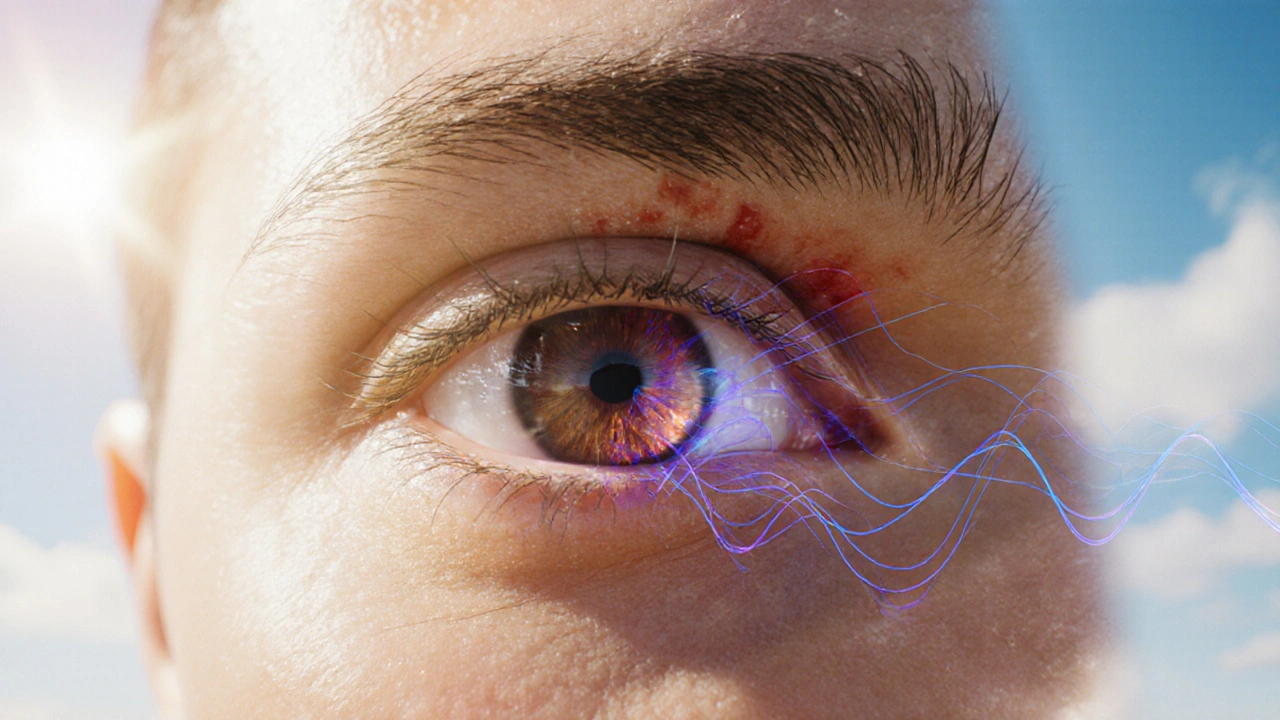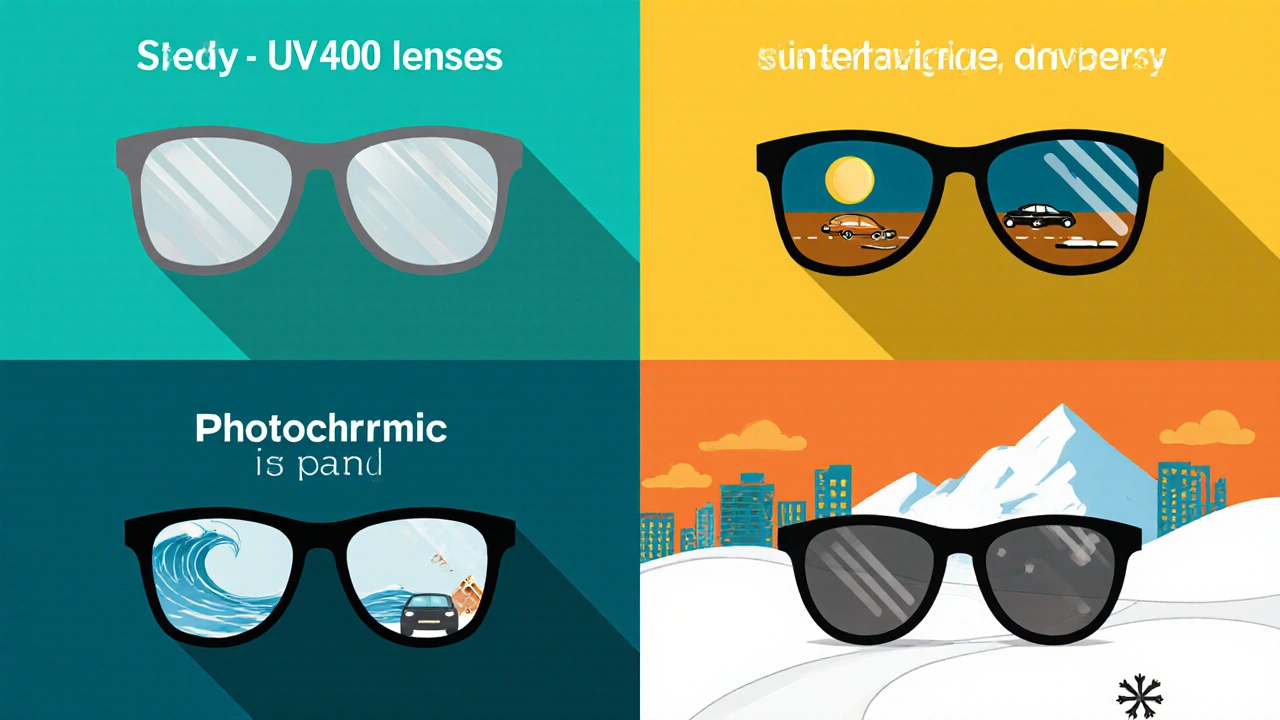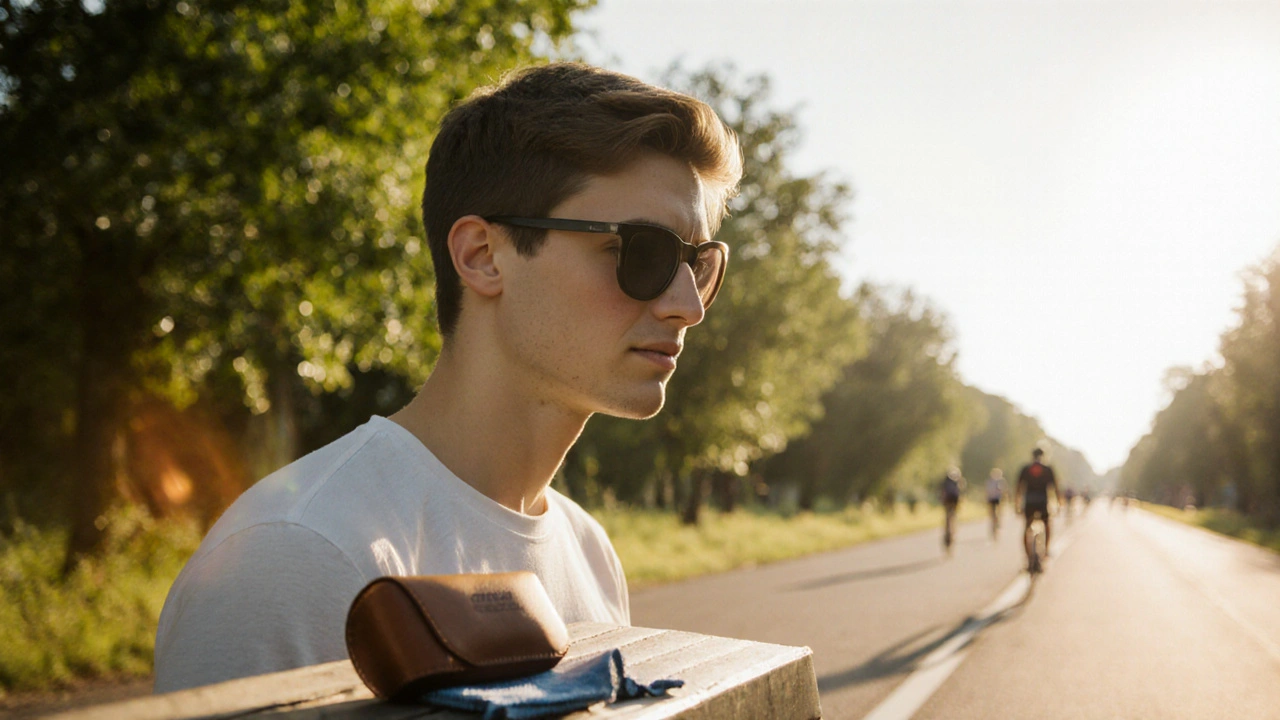
Sunglasses UV Protection Checker
Did you know a single hour of midday sun can deliver enough ultraviolet energy to burn the surface of your eye? While most people scramble for sunscreen on their skin, they often ignore the same threat looming over their eyes. The solution? A good pair of sunglasses that block 100% of UV rays.
Key Takeaways
- UV radiation can cause acute (photokeratitis) and chronic (cataracts, macular degeneration) eye damage.
- Not all tinted lenses block UV; only those labeled 100% UV protection are safe.
- Polarized, photochromic, and wrap‑around styles each have specific advantages for different activities.
- Consistent wear, proper fit, and regular replacement are essential for long‑term protection.
- Understanding common myths helps you choose sunglasses that truly safeguard your vision.
Sunglasses are protective eyewear designed to filter out harmful ultraviolet (UV) radiation while reducing glare. They belong to the broader category of eye protection and have become a fashion staple since the mid‑20th century. The key to their health benefit lies in the lens coating, not the color.
How UV Light Harms Your Eyes
UV radiation is electromagnetic energy with wavelengths between 100 and 400 nanometers, divided into UVA (315‑400nm) and UVB (280‑315nm). While the skin absorbs most of it, a portion reaches the cornea and lens. UVA penetrates deeper, contributing to long‑term problems like cataracts and macular degeneration, whereas UVB is more likely to cause the painful, temporary inflammation known as photokeratitis - often called “snow blindness” or “flash burn.”
The World Health Organization estimates that over 40% of cataract cases worldwide are linked to UV exposure. In Australia, where the UV index regularly spikes above 10 during summer, the risk is even higher. Without adequate shielding, the ocular tissues accumulate microscopic damage that may not show symptoms until decades later.

What Sunburn Looks Like on the Eye
Photokeratitis is the acute sunburn of the cornea and conjunctiva. Symptoms appear within a few hours of exposure and include burning, tearing, red eyes, a sensation of sand in the eye, and temporary vision haziness. It heals in 24-48hours, but repeated episodes accelerate chronic wear.
Long‑term UV exposure can also lead to cataracts, a clouding of the eye’s natural lens that blurs vision and can cause glare sensitivity. Studies from the Australian Institute of Health and Welfare show that people who wear UV‑blocking sunglasses regularly develop cataracts up to 20% later than non‑wearers of the same age group.
Choosing the Right Sunglasses
Not every tinted pair qualifies as eye protection. Look for these three credentials:
- 100% UV Protection: The label should state “UV400” or “blocks 100% UVA and UVB.”
- Lens Quality: Polycarbonate lenses are impact‑resistant and lightweight; glass lenses offer superior optical clarity but can break.
- Fit: Wrap‑around frames block peripheral rays that can enter from the sides.
Beyond the basics, you’ll encounter specialized lens technologies. Here’s a quick rundown:
| Type | UV Protection | Lens Features | Best For |
|---|---|---|---|
| Standard UV400 | 100% UVA/UVB | Fixed tint, basic coating | Everyday city wear |
| Polarized | 100% UVA/UVB | Glare reduction, water/ snow activities | Driving, fishing, skiing |
| Photochromic | 100% UVA/UVB | Darkens in bright light, clears indoors | Transit, variable weather |
| Wrap‑around | 100% UVA/UVB | Full coverage, often polarized | Outdoor sports, high‑speed activities |
When budget allows, consider anti‑reflective (AR) coatings that reduce glare from on‑screen devices and improve night‑time visibility. Mirror finishes are purely aesthetic; they do not increase UV protection but can reduce perceived brightness.
Proper Wear and Care
Even the best lenses won’t protect you if you wear them incorrectly. Here’s a quick checklist:
- Place the lenses over both eyes-no half‑wear.
- Ensure the frames sit snugly against the sides of your face; gaps let stray UV rays in.
- Store in a hard case to avoid scratches that degrade optical quality.
- Clean with a microfiber cloth and lens‑safe solution; avoid paper towels that cause micro‑abrasions.
- Replace every two years or sooner if the lenses become scratched, yellowed, or the frame warps.
Regular eye exams are another layer of defense. Optometrists can assess how well your sunglasses are shielding you and recommend upgrades if they notice UV‑related wear.

Common Myths About Sunglass Protection
Myth #1: “Dark lenses automatically mean better UV protection.” False. Tint only affects visible light; UV blockage depends on the lens material and coating. A cheap dark pair might let 80% of UV through.
Myth #2: “I only need sunglasses on sunny days.” Wrong. UV rays penetrate clouds, snow, and even water. A bright overcast day can have a UV index of 5‑7, enough to cause damage.
Myth #3: “Prescription glasses already protect my eyes.” Most eyeglasses lack UV coating unless specifically added. You still need dedicated sunglasses or clip‑on UV filters.
Next Steps for Everyday Eye Safety
1. Assess your current eyewear. If the label doesn’t say “UV400,” swap them out.
2. Choose a pair that matches your lifestyle-polarized for driving, wrap‑around for sports, photochromic for commuters.
3. Make a habit of wearing them whenever you’re outdoors, even on partly cloudy afternoons.
4. Schedule an eye exam before the next summer to verify your protection level.
5. Keep a spare pair in your bag or car so you never have to go without.
By treating sunglasses as essential health gear rather than optional fashion, you dramatically lower the risk of both short‑term burns and long‑term vision loss.
Frequently Asked Questions
Can I wear regular prescription glasses outdoors instead of sunglasses?
Most prescription lenses lack UV coating, so they don’t block enough radiation. You need either sunglasses with 100% UV protection or clip‑on UV filters designed for your glasses.
Do polarized lenses protect against UV radiation?
Yes, as long as they are labeled UV400. Polarization reduces glare, but UV protection comes from the underlying lens material and coating.
Is it safe to use cheap sunglasses bought online?
Only if the product explicitly states 100% UV protection and comes from a reputable brand. Otherwise, the lenses may let harmful UV rays through despite looking dark.
How often should I replace my sunglasses?
Every two years, or sooner if the lenses are scratched, the coating is peeling, or the frames no longer fit securely.
Are photochromic lenses a good everyday choice?
They work well for people who move between indoor and outdoor environments frequently. They still provide 100% UV protection even when the lenses appear clear indoors.


Comments
Patrick Fithen
Sunlight is more than a bright backdrop it is a cascade of energy that reaches our eyes every day. The lenses we wear can act as guardians against that unseen force. When UV rays strike the cornea they can burn like a tiny ember. Over years that ember can become a cataract clouding the lens. A pair of glasses labeled UV400 tells us that the material blocks the full spectrum. Yet many people think that darkness alone is enough protection. The cultural habit of tying sunglasses to fashion often hides the health message. In societies where outdoor work is common the need for proper eye gear is urgent. Philosophically we can see the eye as a window to the soul that must not be cracked. The window pane can be tempered but only if the glass is made for that purpose. By choosing frames that wrap around we reduce peripheral leaks. Polarized filters cut glare but they still need UV coating to be safe. Photochromic lenses adapt to light yet they retain the same UV block when clear. Regular replacement prevents scratches that let rays through. Ultimately treating sunglasses as essential equipment saves vision and respects the body.
Michael Leaño
Great reminder to wear sunglasses even when the sky looks grey. It’s easy to forget that UV can pierce clouds and still harm the eyes. Your guide breaks down the myths in a way that feels approachable. I especially love the tip about checking for the UV400 label before buying. Keep spreading the word and we’ll all see clearer horizons.
Anirban Banerjee
Dear readers, it is imperative to acknowledge that ultraviolet radiation constitutes a non‑negligible occupational hazard for individuals engaged in outdoor activities. Accordingly, one should procure ocular protection that explicitly certifies 100 % UV blockage, commonly denoted as UV400. Moreover, the selection of wrap‑around frames enhances peripheral shielding, thereby reducing incidental exposure. Regular ophthalmic examinations remain a cornerstone of preventive ocular health. Please ensure that your chosen eyewear complies with these standards to safeguard long‑term vision.
Mansi Mehra
The article is clear and the advice is solid. Make sure the sunglasses say UV400 before you buy them. Avoid cheap dark lenses that do not block UV. Keep them in a case to stop scratches. Replace them after a couple of years.
Jagdish Kumar
Behold, the humble spectacles ascend from mere fashion accessory to heroic sentinel of the ocular realm! When one dons a pair of UV400‑certified lenses, it is as if Apollo himself has gifted a shield to one’s eyes. The drama of light refracting through polished glass is a spectacle worthy of the finest theaters. Yet, without the proper coating, all that grandeur crumbles into a tragic folly. Let the discerning connoisseur select wrap‑around frames, for they envelop the visage like an impenetrable armor, thwarting the sly incursions of peripheral rays. In the grand tapestry of health, such vigilance weaves a pattern of longevity and brilliance.
Aminat OT
Yo i gotta say u really need 2 stop ignorin the sun even if u think u r invincible lol its like ur eyes are beginnnng to scream for help dont wait till its too late get some legit UV400 shades asap u wont rregret
Amanda Turnbo
While the guide offers a comprehensive overview, it omits a critical discussion on the variance in UV protection standards across different manufacturers. A discerning consumer should request certification documentation rather than rely solely on marketing claims. Additionally, the recommendation to replace sunglasses every two years may be overly prescriptive; condition‑based replacement is more pragmatic. Nevertheless, the emphasis on consistent use and proper fit is commendable. Future revisions could benefit from a deeper analysis of lens material durability.
Jenn Zuccolo
In the grand dialogue between light and perception, sunglasses emerge as the silent interlocutor, negotiating the terms of visibility and safety. They remind us that what we choose to shield our eyes from also shapes the narratives we construct about the world. By selecting lenses that honor the full spectrum, we honor the integrity of our own sight. Let this awareness guide not just our fashion, but our philosophy of care.
Courtney The Explorer
UV protection is non‑negotiable.